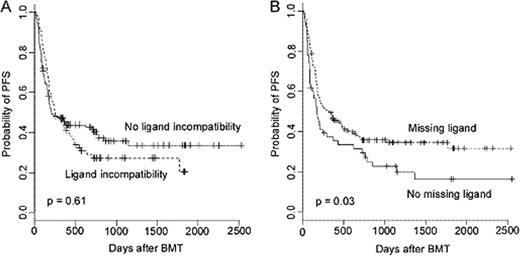Abstract
Abstract 840
Significance of Missing Inhibitory KIR Ligands in Nonmyeloablative, HLA-Haploidentical (Haplo) BMT with Posttransplantation High-Dose Cyclophosphamide (PT/Cy).
Yvette L. Kasamon1, Leo Luznik1, Mary S. Leffell1, Hua-Ling Tsai1, Heather J. Symons1, Javier Bolaños-Meade1, Gary Rosner1, Lawrence E. Morris2, Pamela A. Crilley3, Richard J. Jones1 and Ephraim J. Fuchs1, (1)Johns Hopkins University, Baltimore, MD, (2)Northside Blood and Marrow Transplant Program, Atlanta, GA, (3)Hahnemann University Hospital, Philadelphia, PA
NK cells can influence haplo BMT outcomes including risks of relapse and GVHD. Our group previously reported that, in allogeneic BMT for hematologic malignancies that incorporates PT/Cy, donor-recipient iKIR (inhibitory killer-cell immunoglobulin-like receptor) gene mismatches and having a KIR haplotype B donor were associated with improved outcomes (BBMT 2010;16:533). Because the reported impact of NK cell alloreactivity models in haplo BMT has been variable and some models are relevant to donor selection, we expanded our analysis of iKIR ligand status in this transplantation platform. Patients and methods: Outcomes of 212 uniformly treated patients (pts) enrolled on two similar clinical trials of related-donor, haplo BMT were retrospectively analyzed. Planned treatment consisted of fludarabine (30 mg/m2 IV on days −6 to −2), Cy (14.5 mg/kg IV on days −6 and −5), total body irradiation (200 cGy on day −1), and non-T-cell depleted bone marrow infusion. GVHD prophylaxis consisted of high-dose Cy (50 mg/kg IV on days 3 and 4), mycophenolate mofetil on days 5–35, and tacrolimus on days 5–180 without taper, with filgrastim begun on day 5. All pts (median age 51, range 1–73) had poor-risk hematologic malignancies; 60 (28%) had prior BMT. Diagnoses were Hodgkin lymphoma (31 pts), NHL (69), CLL (21), multiple myeloma (6), acute leukemia or lymphoblastic lymphoma (62), MDS (9), CML (9), CMML (4), PV (1). Missing ligands (ML; defined as absence in the recipient of one or more HLA ligands for iKIRs) and donor/recipient iKIR ligand incompatibility (LI; defined as presence of an iKIR ligand in the donor that is absent in the recipient) were determined using high-resolution HLA typing of class I alleles. For study purposes, HLA-A*2301, A*2402, and A*3201 were included in the Bw4 serologic group and effects attributable to HLA-A3 and A11 ligand groups were excluded. Results: With a median 2.9 year follow-up (range, 0.3–7 years) in pts without events, the actuarial 2-year progression-free survival (PFS) was 34%. On competing-risk analysis, cumulative incidences of grade II–IV acute GVHD and chronic GVHD were 28% and 14%, respectively; 1-year cumulative incidences of relapse and nonrelapse mortality (NRM) were 42% and 14%. Baseline characteristics in pts with ML (157 pts, of whom 76 had LI) and without ML were similar. On univariate analysis, pts with LI had no significant difference in PFS (figure A), grade II–IV acute GVHD, relapse or NRM compared to those without LI. In contrast, as compared to no ML, the presence of ML was associated with a statistically significantly improved PFS on univariate analysis (hazard ratio [HR] = 0.68, p = 0.03; figure B). This association was not identified in our previous analysis, potentially due to underpowering or inclusion of pts receiving one dose of PT/Cy. No statistically significant difference was detected according to the presence or absence of ML in the cumulative incidences of acute GVHD, relapse, or NRM, although presence of ML was associated with a tendency toward lower NRM risk (HR = 0.61, p = 0.17). On multivariate analysis, the presence of ML was found to be independently associated with a significant improvement in PFS (HR = 0.66, p = 0.03). This multivariate model also confirmed our previous observation (BBMT 2010;16:482) that greater donor-recipient HLA disparity was not detrimental to PFS (HR = 0.57, p = 0.04 for 3–4 antigen mismatches versus fewer at HLA-A, B, C, and DRB1 combined). We are currently investigating the impact of KIR haplotypes in this setting with the goal of optimizing donor selection. Conclusion: The presence of ML may be beneficial in haplo BMT with postgrafting immunosuppression that includes high-dose Cy. Further studies are needed to confirm and define the mechanisms of this effect. Our findings do not support selection of donors on the basis of LI in this transplantation platform.
No relevant conflicts of interest to declare.
Author notes
Asterisk with author names denotes non-ASH members.


